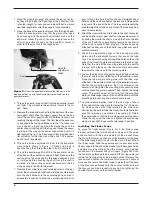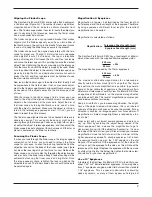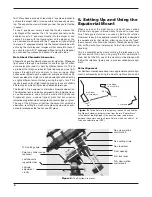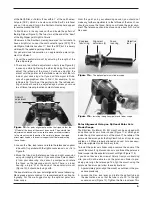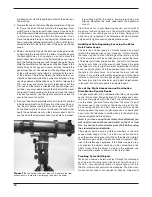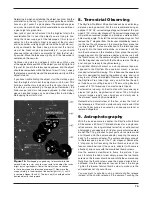
8
faint. Many observers own at least one 2" eyepiece in order to
achieve the widest field of view possible for deep sky-observ-
ing. The expansive view will make you feel like you’re floating
in space!
To use 2" eyepieces, simply loosen the thumb screw on the
star diagonal that secures the 1.25" adapter, and remove the
adapter. Insert a 2" eyepiece directly into the diagonal, and
secure it in place with the thumb screw on the diagonal. You
are now ready to observe with the 2" eyepiece. If you attempt
to place a 2" eyepiece directly into the focuser drawtube with-
out using the star diagonal, images will not come into focus. If
you wish to view with 2" eyepieces without using the diagonal,
you will need to purchase an optional 2" extension tube.
note about chromatic aberration
Chromatic aberration literally means color distortion. Whenever
light passes through one material to another, light of differ-
ent wavelengths (color) is bent by different amounts. This is
a problem that plagues refractor-type telescopes, since light
passes through both air and glass to form an image. Most
astronomical objects emit a spectrum comprised of many dif-
ferent wavelengths of light, so each wavelength will be bent by
a slightly different amount when passing through a lens. This
results in each color of light reaching precise focus at a slightly
different point, which will provide unacceptable images.
The 80mm ED is designed to minimize chromatic aberration.
The objective lens is actually comprised of two individual lens-
es, called elements, one of which is made of ED (Extra-low
Dispersion) glass, a special type of glass that has superior
refractive properties when compared to normal types of glass.
The use of this ED glass minimizes the amount of chromatic
aberration, resulting in a much more pleasing view when com-
pared to telescopes that do not use ED glass.
6. setting up and using the
Equatorial Mount
When you look at the night sky, you no doubt have noticed
that the stars appear to move slowly from east to west over
time. That apparent motion is caused by the Earth’s rotation
(from west to east). An equatorial mount (Figure 8) is designed
to compensate for that motion, allowing you to easily “track”
the movement of astronomical objects, thereby keeping them
from drifting out of your telescope’s field of view while you’re
observing.
This is accomplished by slowly rotating the telescope on its
right ascension (R.A.) axis, using only the R.A. slow-motion
knob. But first the R.A. axis of the mount must be aligned with
the Earth’s rotational (polar) axis - a process called polar align-
ment.
Polar alignment
For Northern Hemisphere observers, approximate polar align-
ment is achieved by pointing the mount’s right ascension axis
Figure 8.
The SkyView Pro mount.
R.A. setting circle
Polar axis finder scope
(optional)
Latitude scale
(opposite side)
Latitude
adjustment
L-bolts
Dec. slow-motion
control knob
Dec. setting circle
Dec. lock lever
Front opening
R.A. lock lever
R.A. slow-motion
control knob
Declination
Axis
Right
Ascension
Axis
Big Dipper
(in Ursa Major)
Little Dipper
(in Ursa Minor)
Cassiopeia
N.C.P.
Pointer
Stars
Polaris
Figure 9.
To find Polaris in the night sky, look north and find the
Big Dipper. Extend an imaginary line from the two "Pointer Stars"
in the bowl of the Big Dipper. Go about five times the distance
between those stars and you'll reach Polaris, which lies within 1° of
the north celestial pole (NCP).




